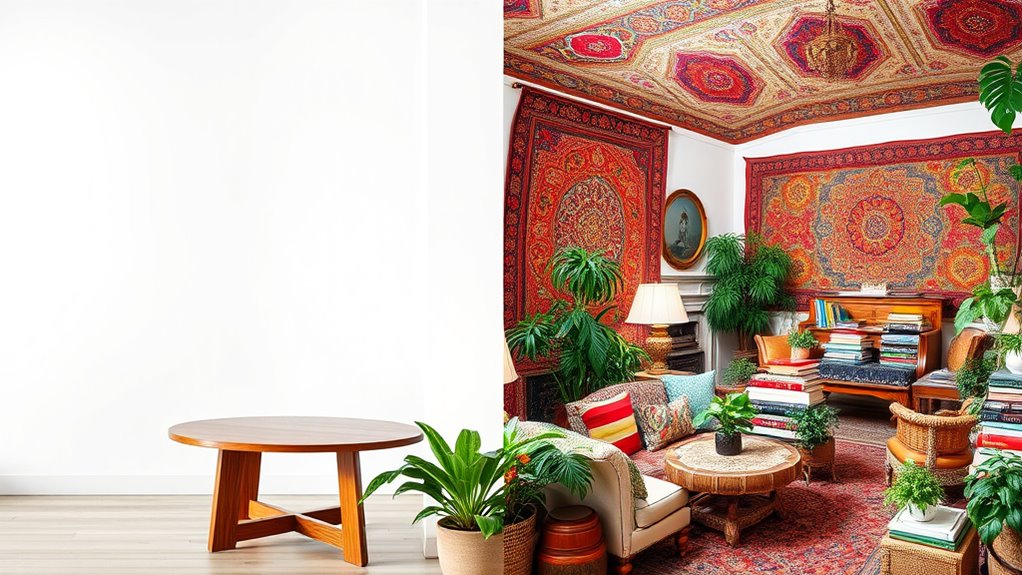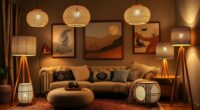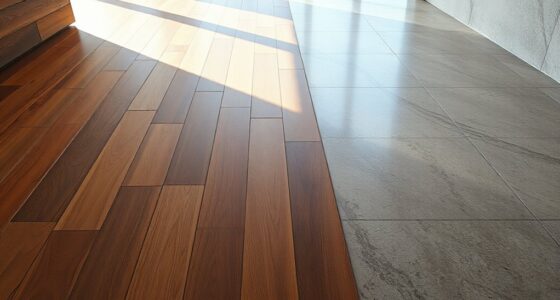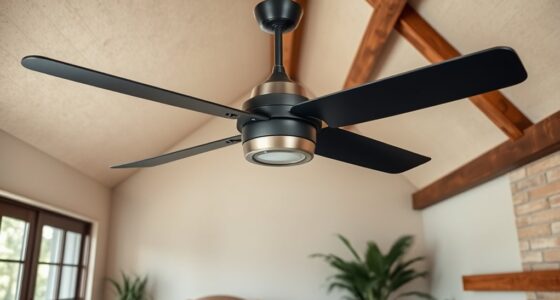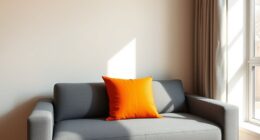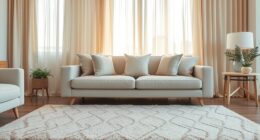If you’re trying to declutter spaces, consider whether you prefer a minimalist approach with simple, functional decor that creates calm or a maximalist style that celebrates layered textures, patterns, and vibrant colors. Minimalism reduces stress and makes cleaning easier, while maximalism adds personality through eclectic accents and bold statements. Finding a balance or combining both methods allows you to create a space that’s stylish, practical, and uniquely yours. Keep exploring to discover how blending these styles can work best for you.
Key Takeaways
- Minimal decor emphasizes reducing clutter, prioritizing essential items, and creating open, calm spaces for clarity and focus.
- Maximal decor involves layered textures, patterns, and decorative items, embracing abundance and visual richness.
- Combining both styles allows for flexible decluttering, maintaining a clean core while adding bold accents seasonally or for personal expression.
- Effective decluttering in minimal spaces improves organization, reduces stress, and enhances functionality.
- Maximal spaces require intentional organization to prevent clutter, highlighting curated decorative elements for visual interest.
Understanding Minimalist Design Principles
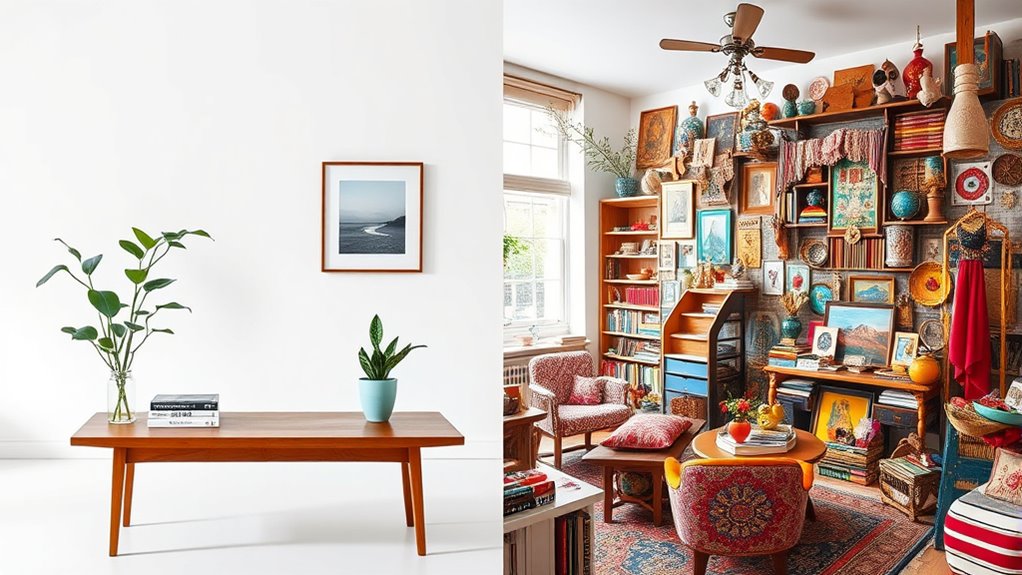
Understanding minimalist design principles involves recognizing the importance of simplicity and functionality. You’ll want to focus on creating open, uncluttered spaces that feel calm and purposeful. Space-saving furniture plays a key role; choose pieces that serve multiple functions or fit seamlessly into your room without overwhelming it. This helps maximize your available space and keeps the environment feeling airy. Color psychology also influences your design choices—select colors that evoke tranquility and clarity, such as neutral tones or soft pastels. These hues can make your space appear larger and more inviting. Incorporating multi-functional furniture can further enhance space efficiency and versatility. By prioritizing essential items, utilizing smart furniture solutions, and thoughtfully choosing colors, you create a harmonious environment that embodies the core principles of minimalism: simplicity, practicality, and serenity.
Embracing Maximalist Aesthetics
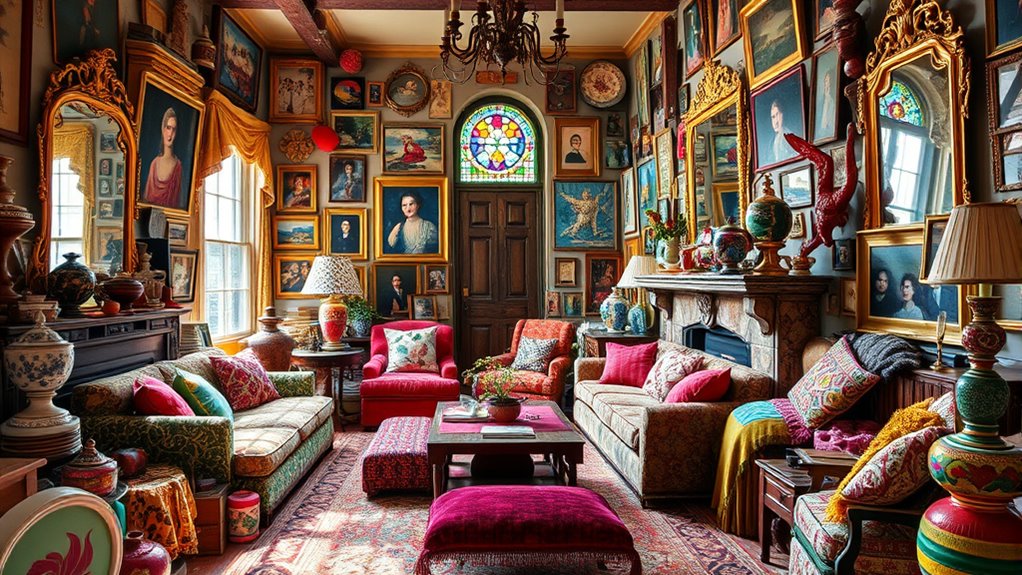
Maximalist aesthetics celebrate rich layering techniques that add depth and interest to your space. Bold colors and varied textures create a vibrant visual impact you can’t ignore. This approach turns your environment into a personal expression space where your personality truly shines. For a farmhouse bedroom, incorporating vintage decor and eclectic accessories can enhance this layered look, making your space uniquely yours.
Rich Layering Techniques
Have you ever wondered how to create a space that feels vibrant and full of personality? Rich layering techniques are your key. By combining different textures, patterns, and scales, you add visual complexity that invites the eye to explore. Start with a bold base—think patterned rugs or textured walls—and build upward with varied furniture and accessories. Mix antique and modern pieces, overlapping artwork, and diverse textiles to create depth. The goal isn’t clutter but intentional layering that tells a story. Pay attention to how each element interacts, balancing busy areas with calmer spaces. This approach allows you to craft a dynamic environment that feels lively yet cohesive, reflecting your personality through thoughtful, deliberate layers. Additionally, understanding the regional resources available can help you select the right pieces and accessories to enhance your layered design.
Colorful Visual Impact
Building on your layered approach, adding bold colors transforms a space into a vibrant showcase of personality. Fiery hues like reds, oranges, and pinks infuse energy, while contrasting accents create visual interest. You can balance these elements with thoughtful placement, ensuring the space feels lively yet cohesive. Incorporate a mix of patterns and textures to amplify the colorful impact without overwhelming. Use this table to guide your choices:
| Fiery Hues | Contrasting Accents |
|---|---|
| Bold reds | Deep navy or black |
| Bright oranges | Metallic gold or silver |
| Vibrant pinks | Cool blues |
This combination energizes your environment, making it memorable and dynamic. Embrace the chaos, but keep a sense of harmony to avoid visual clutter. Remember, understanding narcissistic traits can help you create a space that reflects confidence without feeling overwhelming.
Personal Expression Space
To truly showcase your personality, create a personal expression space that thrives on bold choices and layered details. Maximalist aesthetics celebrate personal expression through space customization, allowing you to fill your environment with meaningful objects, vibrant colors, and diverse textures. Instead of minimalism’s simplicity, embrace clutter as an opportunity to tell your story. Mix patterns, incorporate art pieces, and display collections that reflect your passions. This approach invites creativity and individuality into your space, making it uniquely yours. Every item should serve a purpose or evoke emotion, transforming your space into a vibrant reflection of who you are. With thoughtful layering and deliberate choices, your personal expression space becomes a dynamic canvas for your personality to shine.
The Psychological Impact of Clutter and Space
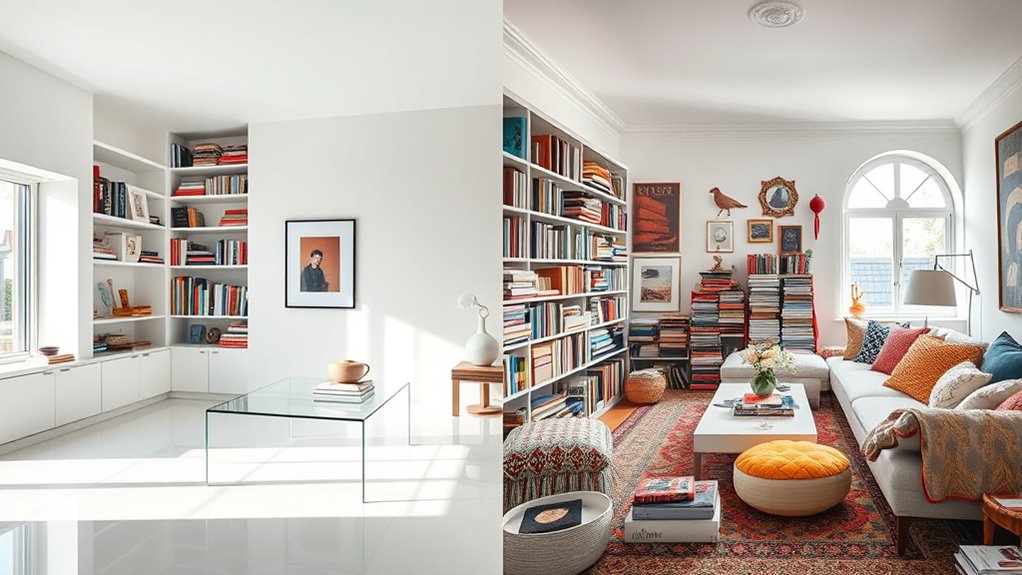
Clutter can substantially influence your mental state, often leading to feelings of stress and overwhelm. When your space is cluttered, it becomes harder to focus, reducing your mental clarity and making daily tasks feel more intimidating. The visual chaos can also drain your emotional well-being, leaving you feeling anxious or irritable. Clearing clutter creates a calmer environment, helping you feel more in control and centered. A tidy space encourages mindfulness, allowing your mind to relax and reset. When your environment supports your mental health, you’re better equipped to handle stress and maintain emotional balance. Recognizing the psychological impact of clutter motivates you to create a space that fosters clarity and promotes overall well-being. Your surroundings directly influence how you feel and think. Additionally, understanding the importance of color accuracy in home environments can help optimize your space for relaxation and mental clarity.
Space Management Techniques in Minimal Decor
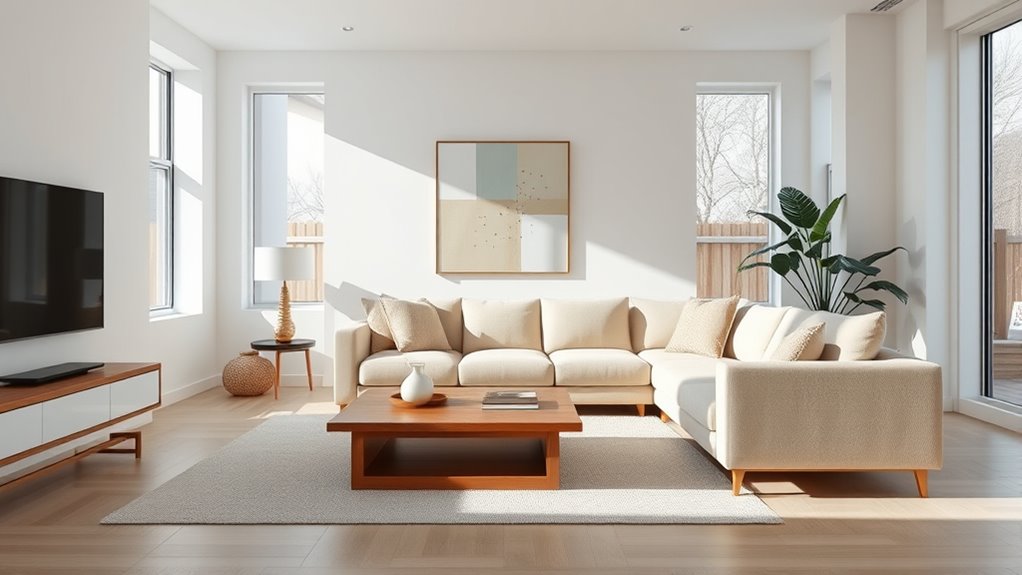
Adopting space management techniques in minimal decor involves intentionally organizing your environment to maximize openness and functionality. Start by selecting storage solutions that hide clutter, such as built-in cabinets or under-bed drawers, keeping surfaces clear. Focus on furniture arrangement by choosing pieces that are proportionate to your space and avoid overcrowding. Position furniture to create open pathways and emphasize a sense of flow. Use multi-functional furniture, like storage ottomans or beds with drawers, to optimize space without sacrificing style. Keep surfaces free of unnecessary items, and regularly declutter to maintain a clean look. Being mindful of space optimization can further enhance the sense of order and tranquility in your environment. These strategies help you achieve a balanced, serene environment where every piece serves a purpose, reinforcing the minimalistic aesthetic and promoting a calm, organized space.
Bold Expressions: Maximalist Style Strategies
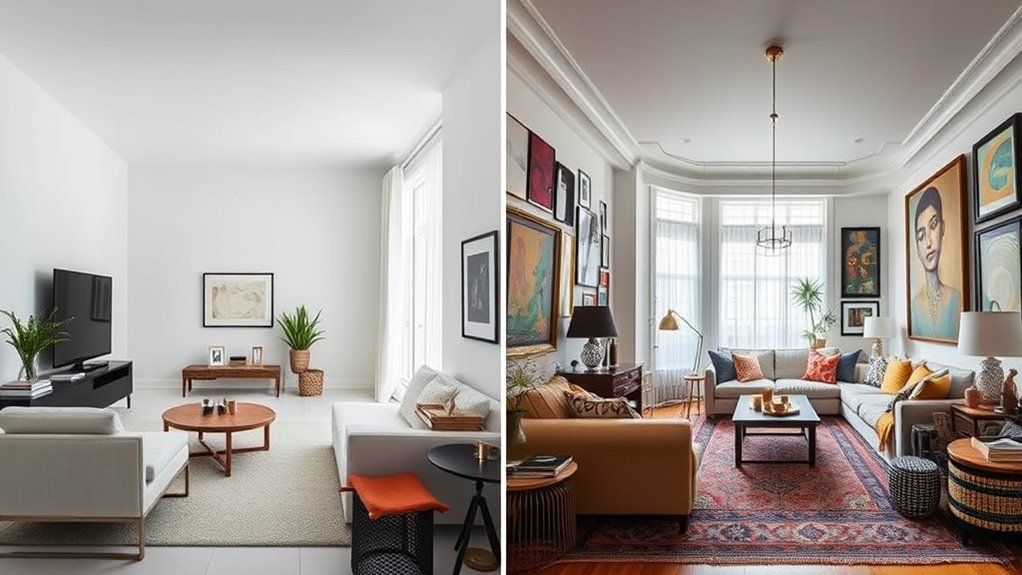
To make a bold statement in your space, start by layering vibrant colors that catch the eye. Mix textures and patterns confidently to add depth and personality. This approach transforms your decor into a lively, expressive environment that showcases your unique style. Incorporating Halloween-themed accents can enhance the festive atmosphere and reflect your seasonal spirit.
Layering Vibrant Colors
Layering vibrant colors is a bold way to express your personality and create a lively, energetic space. To achieve this, focus on color coordination by selecting hues that complement or contrast for maximum impact. Use statement accessories like bold artwork or decorative pillows to anchor your palette. Visualize your space with:
- A rich, emerald green sofa paired with mustard yellow cushions.
- Bright, patterned curtains that incorporate reds, blues, and purples.
- Colorful vases and sculptures that add pops of hue on shelves or tables.
- An accent wall painted in a vivid hue, tying all elements together.
- Incorporating spiritual guidance can help you choose colors that resonate with your emotional energy and intentions.
These layers foster a dynamic environment that invites attention and conversation. Remember, vibrant colors thrive on confident pairings and intentional statement pieces, making your space uniquely yours.
Mixing Textures & Patterns
Building on the vibrant color combinations from before, mixing textures and patterns adds even more personality and depth to your space. Embrace texture contrast by combining smooth and rough surfaces, plush fabrics with sleek finishes, to create visual interest. Pattern mixing allows you to layer different designs—think floral, geometric, or abstract—without overwhelming the room. The key is to balance bold patterns with more subdued ones, ensuring they complement rather than compete. Use accessories like cushions, rugs, or artwork to introduce varied textures and patterns thoughtfully. This approach enhances a maximalist style, making your space feel lively and curated. Remember, intentional pattern mixing and texture contrast are your tools to craft a vibrant, dynamic environment full of character and warmth. Incorporating cybersecurity best practices can also protect your curated spaces, ensuring your personal environment remains safe and private.
Practical Benefits of a Simplified Environment
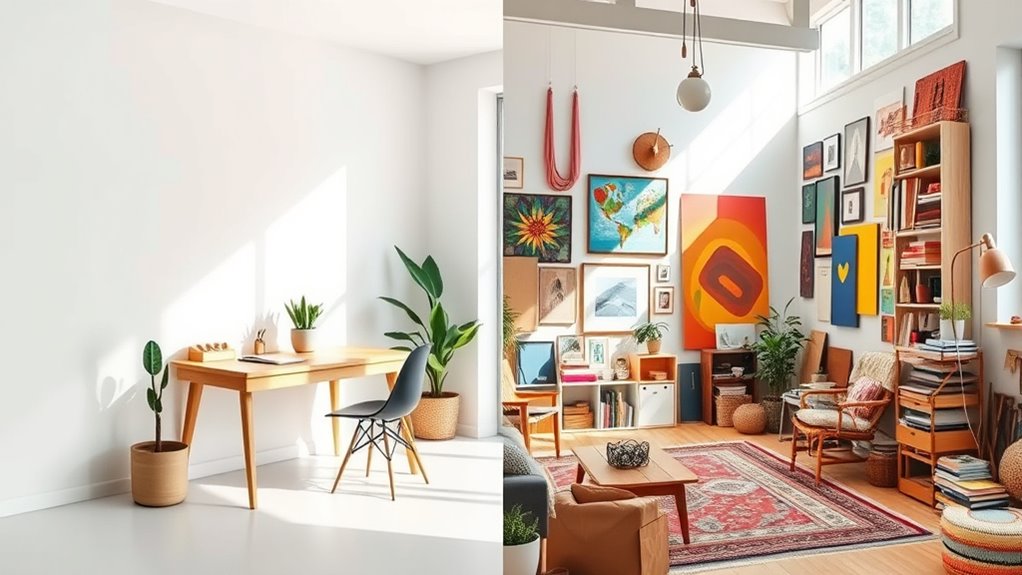
A simplified environment can considerably improve your daily life by making tasks easier and reducing stress. With fewer items cluttering your space, you’ll find it simpler to locate what you need quickly. Consider these practical benefits:
A clutter-free space reduces stress and makes daily tasks more manageable.
- Efficient storage solutions that keep essentials accessible without chaos.
- Streamlined furniture arrangements that create open pathways and reduce accidents.
- Less cleaning time as fewer surfaces gather dust and dirt.
- Enhanced focus by removing distractions, allowing you to concentrate on what matters.
- Improved home organization helps maintain a clutter-free space over time, making ongoing tidying easier and more sustainable.
Creative Freedom in Maximalist Interiors
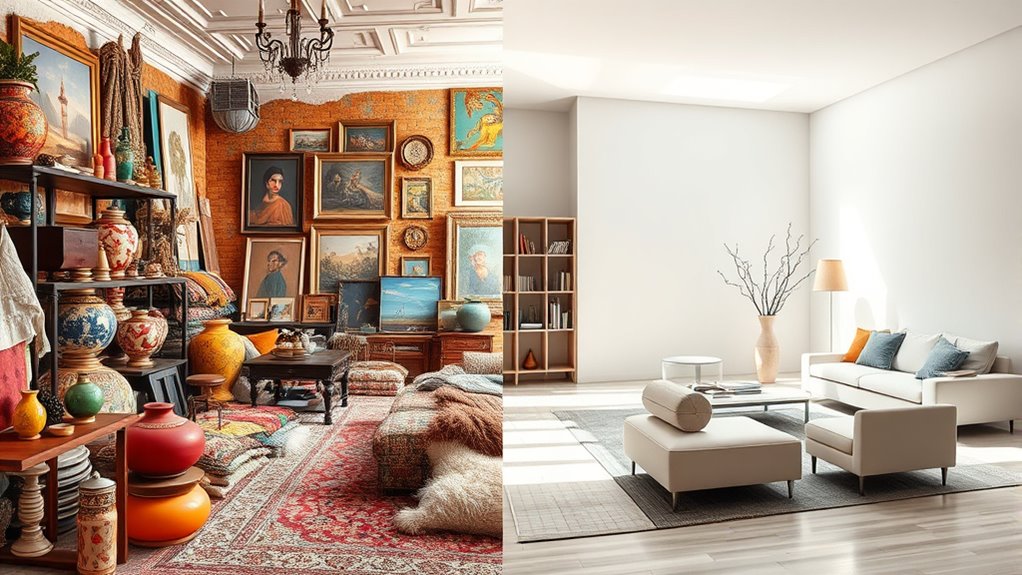
Maximalist interiors release your creative freedom by embracing bold colors, diverse patterns, and eclectic decor without the constraints of minimalism. This style encourages you to express your personality freely, transforming space into a canvas for artistic expression. You can mix vintage pieces with modern accents, layer textures, and experiment with unexpected color combinations. The freedom to combine different styles and objects allows you to showcase your unique tastes without feeling limited. Every corner becomes an opportunity to tell a story or evoke a mood. With maximalism, your imagination takes center stage—you’re inspired to curate a space that reflects your individuality and artistic vision. This approach celebrates abundance, making your environment a vibrant, dynamic reflection of your creative spirit. Additionally, understanding how decor styles influence the overall ambiance can help you make more intentional design choices.
Balancing Functionality and Aesthetics
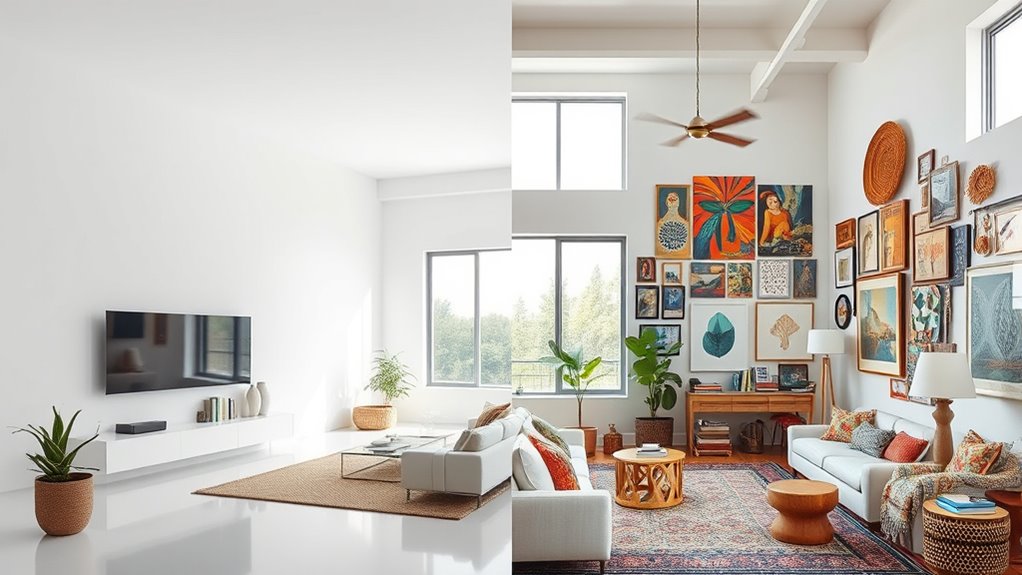
Striking a balance between functionality and aesthetics is essential when designing a space that looks good and works well. You can achieve this by carefully selecting storage solutions that keep clutter out of sight, such as sleek cabinets or open shelves. Consider your lighting choices: warm lights create a cozy atmosphere, while bright LEDs enhance productivity. Visualize these elements working together:
- Hidden compartments to store everyday items effortlessly
- Statement lamps that add style and illuminate your space
- Multi-purpose furniture that combines form and function
- Decorative baskets or trays to organize smaller essentials
– Incorporating organizing techniques can further optimize space and reduce visual clutter, making your environment both attractive and practical.
Tips for Transitioning Between Styles
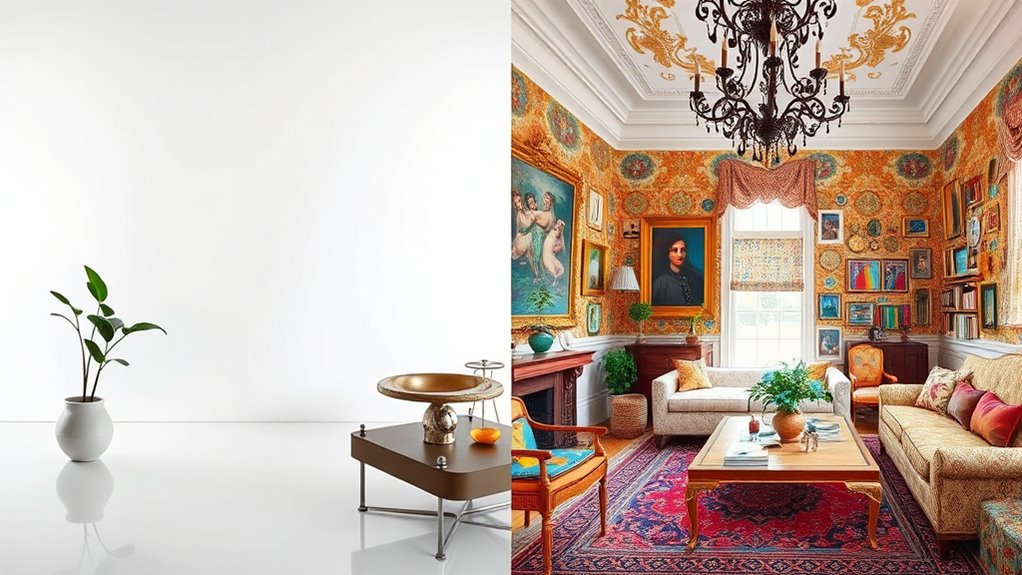
To smoothly shift between styles, start by gradually introducing new elements into your space. Curate key pieces that embody your desired look, and update the color palette to create harmony. This approach helps your space evolve naturally without feeling overwhelming. Incorporating minimalist decor elements can further enhance the transition and maintain a cohesive aesthetic.
Gradual Style Integration
Switching between different interior styles can feel overwhelming, but a gradual approach makes the process manageable and more enjoyable. Start by selecting one small area, like a centerpiece or a shelf, to incorporate new design elements. Use seasonal decorating to introduce subtle changes without full commitment. Incorporate DIY decor ideas, such as handcrafted wall art or customized vases, to reflect your evolving style. Focus on these steps:
- Swap in new accent pieces that match your desired style.
- Replace or update textiles like cushions and throws.
- Add curated decor items that showcase your personality.
- Rotate seasonal decor to refresh the space periodically.
- Pay attention to design consistency to create a cohesive look over time.
This method allows you to experiment comfortably, blending styles over time. It keeps your space dynamic without feeling chaotic, making the *changeover* seamless and fun.
Curate Key Pieces
As you gradually introduce new decor elements, focusing on key pieces helps create a cohesive look that reflects your evolving style. Select statement pieces that stand out and serve as focal points within your space. These items anchor your decor, drawing attention and setting the tone for your overall aesthetic. For a minimalist approach, choose a few impactful pieces—like a bold sculpture or a striking chair—that add personality without clutter. In a maximalist setting, layer statement pieces to build visual interest, making sure each one complements the others. Remember, curating these key pieces allows you to shift smoothly between styles while maintaining harmony. By thoughtfully selecting focal points, you reinforce your space’s identity and ensure your decor feels intentional and balanced. Incorporating bold accent pieces can also enhance the overall style and serve as conversation starters.
Adjust Color Palettes
Adjusting your color palette is a powerful way to smoothly shift between styles and refresh your space. Start by selecting colors that enhance your desired mood, considering color harmony for a cohesive look. To create palette contrast, choose one bold accent hue and balance it with neutral tones. Visualize this process:
- Swap out bright, energetic colors for muted pastels or earthy tones.
- Replace cluttered patterns with solid, harmonious shades.
- Introduce a statement piece in a contrasting color for focal interest.
- Use accessories like cushions or art to subtly shift the overall vibe.
- Keep in mind support hours for any decorating store visits to ensure you can get assistance when shopping for new palette elements.
When to Combine Elements of Both Approaches
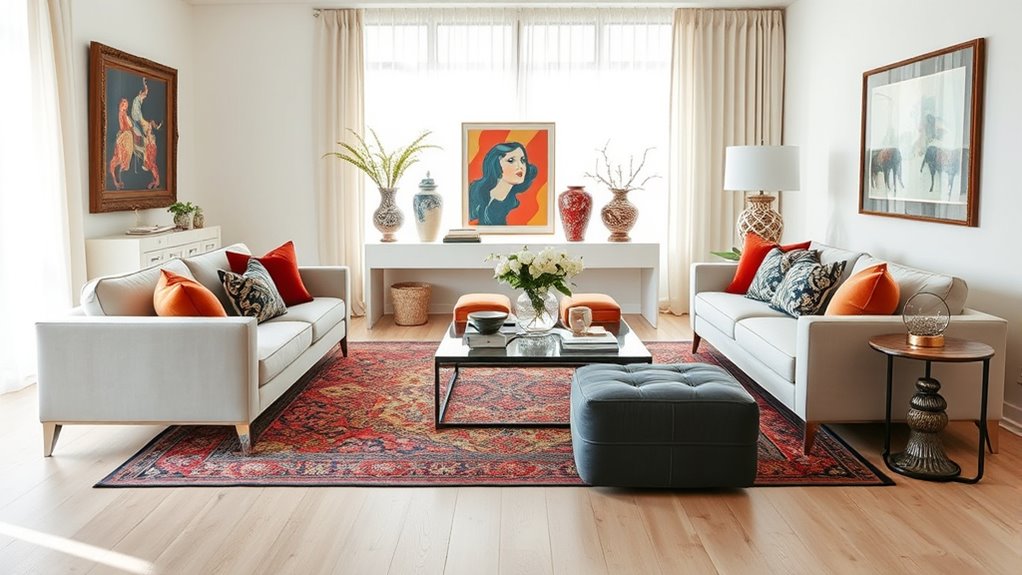
Knowing when to combine elements of both minimalism and maximalism can considerably enhance your space’s functionality and aesthetic. This blend works well during seasonal decorating, allowing you to keep the core minimal while adding bold, maximalist accents for special occasions. It also supports budget-friendly styling by mixing a few statement pieces with basic essentials.
| When to Combine | How to Do It |
|---|---|
| Seasonal Decor | Use minimal base, add maximal accents during holidays |
| Budget Styling | Mix simple furniture with eye-catching accessories |
This approach keeps your space dynamic without feeling cluttered, creating a balanced environment that adapts to different needs. You enjoy the best of both worlds—simplicity and personality.
Frequently Asked Questions
How Do I Choose Between Minimal and Maximal Decor for My Space?
You should choose between minimal and maximal decor based on your personality and how you want your space to feel. If you prefer calm, simple surroundings, go for minimal decor with neutral color schemes and sleek furniture styles. If you love vibrant energy and statement pieces, opt for maximal decor with bold colors and eclectic furniture styles. Consider what makes you feel most comfortable and inspired in your space.
Can I Incorporate Elements of Both Styles Without Clutter?
Absolutely, you can blend styles through creative mixing without clutter. Focus on balancing the minimal and maximal elements, such as pairing a simple, clean sofa with bold, decorative accents. Use a neutral background to keep the space feeling open, while adding statement pieces for visual interest. By thoughtfully combining these styles, you create a unique, harmonious look that reflects your personality without feeling overwhelming or cluttered.
What Are the Cost Differences Between Minimalist and Maximalist Interior Design?
Think of interior design like planting a garden—minimalism is a single, elegant rose, while maximalism blooms with many vibrant flowers. Minimalist spaces often cost less because they favor fewer pieces and streamlined furniture, making budget planning easier. Maximalist decor can be pricier due to more accessories, art, and textiles. A thorough cost analysis helps you balance your style and budget, ensuring you create a stunning space without overspending.
How Do Lighting Choices Vary in Minimal Versus Maximal Decor?
In minimal decor, you prefer ambient lighting with simple fixtures, creating a calm, uncluttered atmosphere. In maximal decor, you opt for statement fixtures that serve as focal points, adding drama and personality. You’ll use layered lighting to highlight bold patterns or abundant decor pieces, while in minimal spaces, you keep lighting subtle and functional. Your choice reflects your style—understated elegance or vibrant extravagance.
Are There Specific Room Types Better Suited for Each Style?
You’ll find that minimal decor suits small living rooms and bedrooms, enhancing decor style compatibility with clean lines and a simple color palette. Maximal decor works well in larger spaces like open-plan living areas or spacious bedrooms, where bold patterns and vibrant color palette choices add personality. Ultimately, consider your room size and the vibe you want to create; both styles can adapt beautifully to different room types.
Conclusion
Whether you prefer the simplicity of minimalism or the vibrant energy of maximalism, finding your style is like tuning a fine instrument—you’ll create a space that resonates with your personality. Experiment, blend elements, and trust your instincts. Remember, your home should reflect who you are, not just follow trends. Embrace the journey of decluttering and decorating, and let your space be a canvas as unique as you are.

